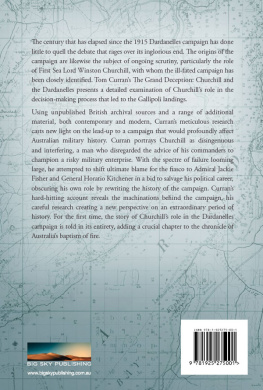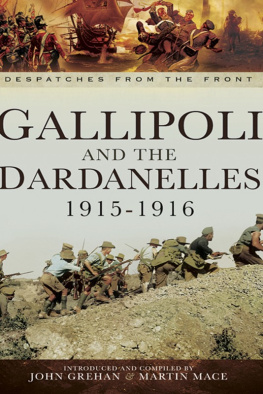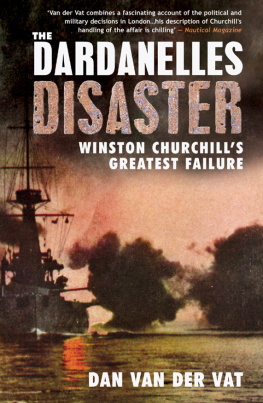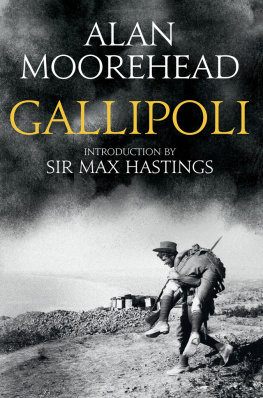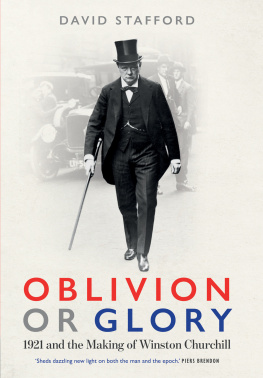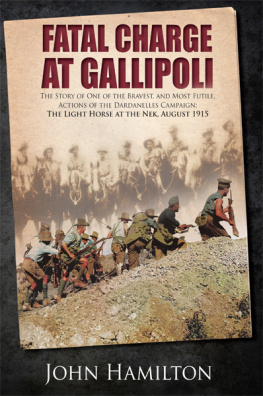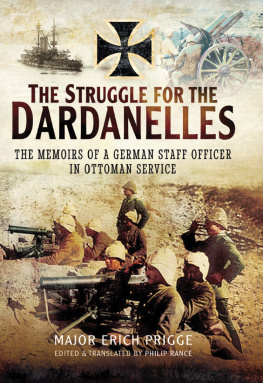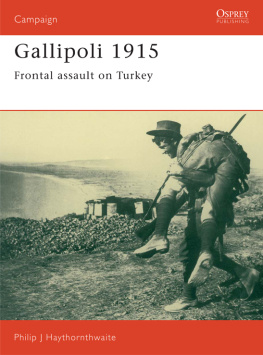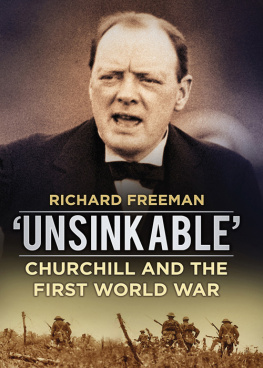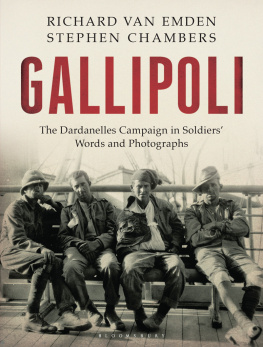THE GRAND
DECEPTION
Churchill and the Dardanelles

TOM CURRAN
Edited By Andrew G. Bonnell
Copyright Tom Curran
First published 2015
Copyright remains the property of the Commonwealth and apart from any fair dealing for the purposes of private study, research, criticism or review, as permitted under the Copyright Act, no part may be reproduced by any process without written permission.
All inquiries should be made to the publishers.
Big Sky Publishing Pty Ltd
PO Box 303, Newport, NSW 2106, Australia
Phone: 1300 364 611
Fax: (61 2) 9918 2396
Email:
Web: www.bigskypublishing.com.au
Cover design and typesetting: Think Productions
Printed in China by Asia Pacific Offset Ltd.
See National Library of Australia for Cataloguing-in-Publication entry
ISBN: 978-1-925275-00-1
THE GRAND
DECEPTION
Churchill and the Dardanelles

TOM CURRAN
Edited By Andrew G. Bonnell
THE AUSTRALIAN ARMY HISTORY COLLECTION

Winning with Intelligence
Judy Thomas
Duntroon
Darren Moore
The Warrior Poets
Robert Morrison
The History of the Royal Australian Corps of Transport 19732000
Albert Palazzo
Defenders of Australia
Albert Palazzo
The Fight Leaders
D. Butler, A. Argent and J. Shelton
Operation Orders
Pat Beale
Little by Little
Michael Tyquin
Red Coats to Cams
Ian Kuring
Bowler of Gallipoli
Frank Glen
Vets at War
Ian M. Parsonson
Only One River to Cross
A.M. Harris
The Fragile Forts
Peter Oppenheim
Hassett: Australian Leader
John Essex-Clark
Persian Expedition
Alan Stewart
The Chiefs of the Australian Army
James Wood
Never Late
Gordon Dickens
To Villers-Bretonneux
Peter Edgar
Madness and the Military
Michael Tyquin
The Battle of Anzac Ridge
25 April 1915
Peter D. Williams
Doves Over the Pacific
Reuben R.E. Bowd
The Lionheart
David Coombes
Battlefield Korea
Maurie Pears
Chemical Warfare in Australia
Geoff Plunkett
A Most Unusual Regiment
M.J. Ryan
Between Victor and Vanquished
Arthur Page
Country Victorias Own
Neil Leckie
Surgeon and General
Ian Howie-Willis
Willingly into the Fray
Catherine McCullagh
Beyond Adversity
William Park
Crumps and Camouflets
Damien Finlayson
More than Bombs and Bandages
Kirsty Harris
The Last Knight
Robert Lowry
Forgotten Men
Michael Tyquin
Battle Scarred
Craig Deayton
Crossing the Wire
David Coombes
Do Unto Others
Alan H Smith
Fallen Sentinel
Peter Beale
Sir William Glasgow
Peter Edger
Training The Bodes
Terry Smith
Bully Beef and Balderdash
Graham Wilson
Fire Support Bases Vietnam
Bruce Picken
Toowoomba to Torokina
Bob Doneley
A Medical Emergency
Ian Howie-Willis
Dust, Donkeys and Delusions
Graham Wilson
The Backroom Boys
Graeme Sligo
Captains of the Soul
Michael Gladwin
CONTENTS
LIST OF ILLUSTRATIONS
Winston Churchill as a Member of Parliament, 1904.
Winston Churchill as First Lord of the Admiralty, May 1914, with the Naval Wing of the Royal Flying Corps.
Admiral Sir John Jacky Fisher.
The Dardanelles forts: view across The Narrows to Chanak from above Kilid Bahr, December 1918.
The naval bombardment of the Dardanelles entrance forts, 19 February 1915.
Dardanelles Attacked, The Times, 22 February 1915, p. 6.
The Allied Attack On The Dardanelles, The Times, 22 February 1915, p. 7.
A Turkish 9.4-inch Krupp gun wrecked in its emplacement at Fort No. 1 on the cliffs of Cape Helles.
The French battleship Bouvet sinks after hitting a mine, 18 March 1915.
The battleship HMS Queen Elizabeth leaving the island of Lemnos in the Aegean.
The 15-inch guns of HMS Queen Elizabeth at Gallipoli.
Popular satirical appreciation of Churchill as the heir to Marlborough from Punch or The London Charivari, 19 July 1916.
HMS Queen Elizabeth under Turkish fire off Cape Helles.
Churchills and Asquiths performances before the Dardanelles Commission, Punch, 28 March 1917.
MAPS
The Balkans, August 1913 ().
Anglo-French naval attack on the Dardanelles, 18 March 1915 ().
From the Curran family:
T.C.
Husband, Dad, Pa Tom, Wordsmith,
Brother, Son & Friend.
You were a man of words. Throughout your lifetime, writing gave you the greatest pleasure and was also a necessity akin to breathing. What a rollercoaster ride this has been in your quest for a hidden truth to be shared. We are so very proud and miss you every single day.
Always in our hearts,
Your family (the Currans).
A reader might justifiably wonder whether there can be anything new to say about either the history of the Dardanelles campaign or Winston Churchill. A subject search for Gallipoli in the catalogue of the National Library of Australia brings up 859 entries (last time I looked the number will no doubt continue to grow as the centenary inexorably approaches). As for Churchill, there are entire libraries devoted to him. The online British Library catalogue lists 555 titles on Churchill alone. The official biography, commenced by Randolph S. Churchill and continued from Volume 3 to 8 by Martin Gilbert, with its documentary companion volumes, constitutes an apparently definitive monument to the statesman, and a rich quarry for subsequent researchers.
Naturally, therefore, I was also sceptical when Tom Curran approached Professor Paul Crook and me at the University of Queenslands Department of History in 2001with the proposal to write a PhD on the full story of Churchill and the Dardanelles campaign. I initially reckoned without Toms dogged tenacity as a researcher and the enthusiasm and energy with which he pursued his project.
Tom Curran was a remarkable man. He came from the region near Newcastle on Tyne (born 1938), from a modest working-class background his father was a shipyard painter. His earliest memory as a toddler was of having to put on a gas mask during the Blitz, when the German Luftwaffe bombed the Newcastle dockyards. Tom never lost his Geordie accent, despite decades in Australia. He found his way to Australia after qualifying as a pharmacist in Edinburgh in 1961. In 1966 he enlisted in the Royal Australian Army Medical Corps which took him to Vietnam where he commanded a field medical supply unit in 1969. He was promoted captain in the field after the previous commander of the unit became a casualty. Like many veterans of that conflict, Tom suffered severe health problems after his return from Vietnam, through which he was sustained by a strong and loving family, his wife Maureen, and his daughters Chris, Joc and Ky.
When Tom returned from Vietnam, but while he was still serving in the Army (posted to Townsville), he became acquainted with the story of John Simpson Kirkpatrick, and was struck by the fact that there was no modern biography of the man with the donkey from Gallipoli. Tom felt considerable empathy with Simpson, another migrant to Australia from the Tyneside who served in the Army medical service, and he set out on a long quest to document and write Simpsons life. He began studying for a Bachelor of Arts in the mid-1980s, but was forced to interrupt his studies. In 1994 his biography of Simpson appeared (
Next page
